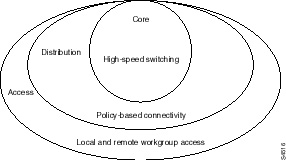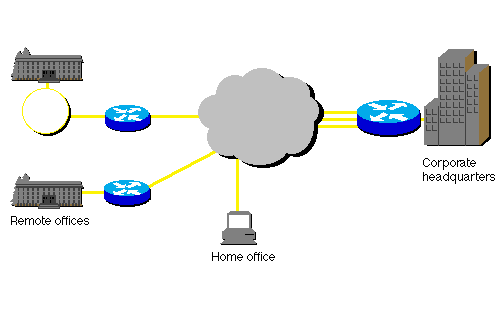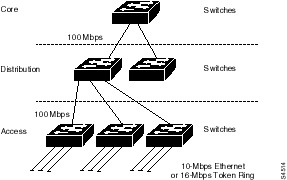
Table of Contents

Module 2 - Design the Network Structure
Section 1 - Design the Topology
Part A - Hierarchical Models
Introduction
Hierarchical models let you design internetworks in layers. To understand
the importance of layering, consider the Open System Interconnection (OSI)
reference model, which is a layered model for implementing computer communications.
Using layers, the OSI model simplifies the tasks required for two computers
to communicate. Hierarchical models for internetwork design also use layers
to simplify the tasks required for internetworking. Each layer can be focused
on specific functions, allowing you to choose the right systems and features
for each layer.
Benefits of Hierarchical Models
After adopting hierarchical design models, many organizations report
cost savings because they are no longer trying to do it all in one routing/switching
platform. The modular nature of the model enables appropriate use of bandwidth
within each layer of the hierarchy, reducing wasted capacity.
Ease of Understanding
Keeping each design element simple and small facilitates ease of understanding,
which helps control training and staff costs. Management responsibility
and network management systems can be distributed to the different layers
of a modular network architectures, which helps control management costs.
Easy Network Growth
Hierarchical design facilitates changes. Modularity in a network design
enables creating design elements that can be replicated as the network
grows, facilitating easy network growth. As each element in the network
design requires change, the cost and complexity of making the upgrade is
contained to a small subset of the overall network. In large, flat, or
meshed network architectures, changes tend to impact a large number of
systems.
Improved Fault Isolation
Improved fault isolation is facilitated by the modular structuring of the
network into small, easy-to-understand elements. Network managers can easily
understand the transition points in the network, which helps identify failure
points.
Today's fast-converging protocols were designed for hierarchical topologies.
To control the impact of routing overhead processing and bandwidth consumption,
modular hierarchical topologies must be used with protocols such as Enhanced
IGRP.
Route summarization, which we will talk more about in Section
4 of Module 2, "Design a Network-Layer Addressing and Naming Model"
is facilitated by hierarchical network design. Route summarization reduces
the routing protocol overhead on links in the network and reduces routing
protocol processing within the routers.
Hierarchical Network Design
A hierarchical network design has three layers:
-
The core layer provides optimal transport between sites.
-
The distribution layer provides policy-based connectivity.
-
The access layer provides workgroup/user access to the network.

Each layer provides necessary functionality to the network. The layers
do not need to be implemented as distinct physical entities. Each layer
can be implemented in routers or switches, represented by a physical media,
or combined in a single box. A particular layer can be omitted altogether,
but for optimum performance, hierarchy should be maintained.
Core Layer
The core layer is the high-speed switching backbone of the network, which
is crucial to enable corporate communications. The core layer should:
-
Offer high reliability.
-
Provide redundancy.
-
Provide fault tolerance.
-
Adapt to changes quickly.
-
Offer low latency and good manageability.
-
Avoid slow packet manipulation caused by filters or other processes.
-
Have a limited and consistent diameter.
Distribution-layer routers and client LANs can be added to the hierarchical
model without increasing the diameter. Limiting the diameter of the internetwork
provides predictable performance and ease of troubleshooting.
Distribution Layer
The distribution layer of the network is the demarcation point between
the access and core layers of the network. The distribution layer can have
many roles, including implementing the following functions:
-
Policy
-
Security
-
Address or area aggregation
-
Departmental or workgroup access
-
Broadcast/multicast domain definition
-
Routing between virtual LANs (VLANs)
-
Media translations
-
Redistribution between routing domains
-
Demarcation between static and dynamic routing protocols
Several Cisco IOS software features can be used to implement policy at
the distribution layer:
-
Filtering by source or destination address
-
Filtering on input or output ports
-
Hiding internal network numbers by route filtering
-
Static routing
-
Quality of service mechanisms
Access Layer
The access layer provides user access to local segments access on the network.
The access layer is characterized by switched and shared-bandwidth LANs
in a campus environment. Microsegmentation, using LAN switches, provides
high bandwidth to workgroups by dividing collision domains on Ethernet
segments and reducing the number of stations capturing the token on Token
Ring LANs.
For small office/home office (SOHO) environments, the access layer provides
access for remote sites into the corporate network using wide-area technologies
such as ISDN, Frame Relay, and leased lines. Features such as dial-on-demand
(DDR) routing and static routing can be implemented to control costs.
For small- to medium-sized companies, the hierarchical model is often
implemented as a hub-and-spoke topology. Corporate headquarters form the
hub. Links to the remote offices form the spokes.
Example Switched Hierarchical Design
Example Routed Hierarchical Design

Click on the Back button in your browser or click
here to go back to Section 1 of Module 2, "Design the Topology."
Copyright Cisco Systems, Inc. -- Version 2.0 7/98





